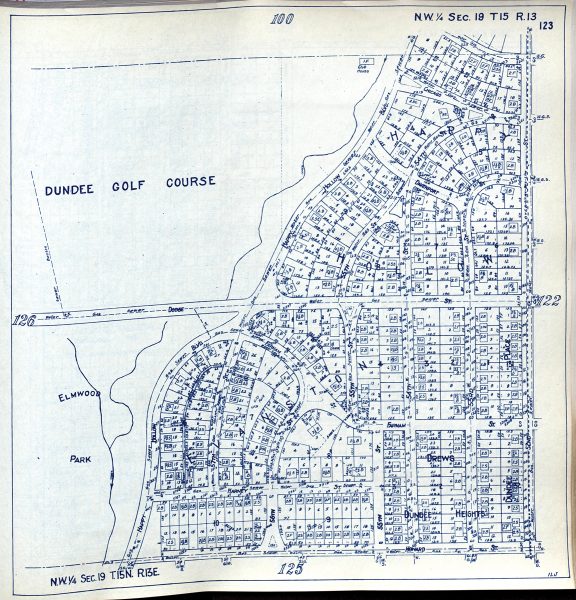On weekdays, the stretch of Farnam between Saddle Creek Road and Happy Hollow Boulevard becomes a one-way street for two, two-hour periods: eastbound 7-9 a.m. and westbound 4-6 p.m. Numerous “Do Not Enter” and one-way reminder signs are posted prominently throughout the mile-long route.
Signs are not enough, says 30-year Dundee resident Jim McGee, a retired state traffic agency employee. A social media search (#FixFarnam) reveals anecdotes of near-misses and photos of vehicles heading the wrong way during the one-way period or that jumped a curb to avoid oncoming traffic. Even conscientious drivers misjudge the time of day, McGee says, and end up in hazardous situations.
“I’ve seen police cars do it. I’ve seen delivery trucks to it. I’ve seen people who’ve lived in this neighborhood do it. They just forget, you know,” he says. “There are driveways and streets you can access Farnam from, and people that are pulling out onto Farnam don’t know it’s one-way at that time.”
With the exception of a few businesses like KPTM-TV, Holland Basham Architects, and Rathskeller Bier Haus, the section of Farnam within the Dundee-Happy Hollow Historic District is residential, with some of the homes now a century old and others representing architectural trends throughout the first half of the 20th century.
“Farnam’s reversible lanes were implemented during a time when safety and neighborhood preservation were not priorities,” McGee says. “The economic value of historic neighborhoods wasn’t recognized.”
r r
r
Peter Manhart, president of the Dundee-Memorial Park Association, lives in the neighborhood close to his childhood home, where his mother still resides. He calls the switching one-way designation of Farnam Street “nonsensical.”
“We’ve dealt with this our whole lives,” he says. “We don’t know of one neighbor, ever, who thinks this is a good system.”
City engineer Todd Pfitzer, who’s worked for the City of Omaha for 12 years, says he can’t answer for his predecessors, but it’s been long understood that one-way hours were established in response to downtown commuter traffic patterns.
“I’m assuming it’s for the same reason it’s still needed today, to carry the eastbound capacity in the morning and the westbound capacity in the afternoon,” he says.
Manhart says that downtown workers commuting en masse during fixed hours may have reflected the scene in 1958 but doesn’t fit today’s workforce.
“People are not rushing to get to work right at nine o’clock all at the same time. Employers are much more flexible than they’ve ever been, and so many people work from home,” he says.
McGee says taking Dodge (a major artery one street north) is the better—and far more popular choice—for commuters on any given day.
“Under perfect conditions, the reversible lanes [on Farnam] probably only carry a thousand cars and trucks. Most people totally avoid using them,” he says. “I believe traffic is down from 15 years ago on Dodge; there’s plenty of capacity on Dodge to move.”
He adds, “The reversible lanes have added single direction ‘capacity’ but the practice is not standard and is confusing to many. Minor collisions occur nearly every day. Distracted motorists are an added factor today.”
Pfitzer says studies show safety is not significantly compromised on Farnam and that the flexible one-way designations are necessary to accommodate traffic.
“It’s no more dangerous than other comparable streets. We’ve compared it to streets with similar traffic, volumes, similar speed limits, similar conditions. And it doesn’t have any tendencies to being a higher risk or more dangerous corridor than it should, frankly. And certainly the benefits of being able to move the traffic at peak times of the day are great,” he says, adding that his department considers safety, too. “We don’t currently have the capacity on Dodge Street during those times; if we take Farnam Street away we are going to experience excessive delays, additional delays, on Dodge Street. And additional delays always lead to additional safety concerns.”
McGee says differences of opinion are to be expected.
“Perhaps the traffic engineers aren’t the best people to be deciding the future of a historic neighborhood. I’d like to see Farnam taken out of the deck of options of westbound traffic. I mean, face it, it goes right back to westbound Dodge [merging at Happy Hollow Boulevard] in the first place,” he says. “The ideal solution for Dundee would be to return Farnam to its historic design, which ended at Happy Hollow.”
It’s highly unlikely the city would ever sever the connection from Farnam to Dodge near Elmwood Park, he says. However, “the simplest and safest solution is to return Farnam to a full-time two-way street…It isn’t that hard to do since it is actually two-ways 20 hours a day.”
An online petition to change Farnam to 24/7 two-way was posted by the Dundee-Memorial Park Association on the website change.org three years ago and garnered 535 supporters. Residents of the area like McGee and Manhart regularly remind city government of their point of view.
“They know who to contact, trust me,” Pfitzer says.
“All we want is the street to go back to the way it should have always been,” Manhart says.
Forthcoming changes affecting the area—from the bus rapid transit system in the works to redevelopment at the former Omaha Steel Castings site west of the University of Nebraska Medical Center campus—may actually bring the issue of changing Farnam (or rather, changing Farnam back) to discussion again soon, Pfitzer says.
“There are a lot of things going on that could drastically change travel patterns in the area and just the landscape of things to come,” he says. “Let some of these things happen that will undoubtedly change some of the transportation patterns, and then look at it with a fresh set of eyes and see if it’s prudent to make those changes.”
r
Visit dundee-memorialpark.org for more information about the Dundee-Memorial Park Association.
rThis article was printed in the January/February 2019 edition of OmahaHome. To receive the magazine, click here to subscribe.











